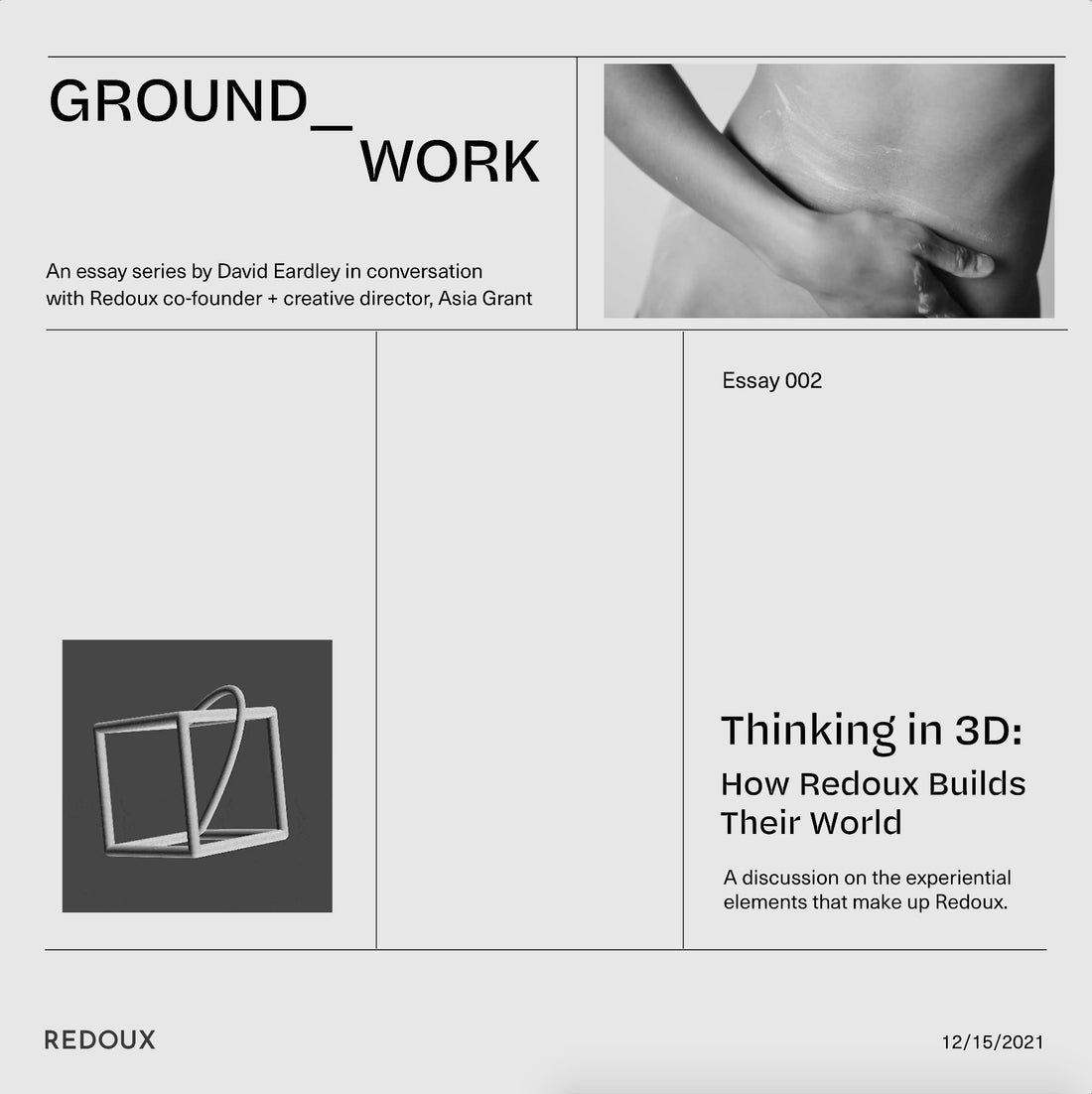
GROUND_WORK 02: Thinking in 3D - How Redoux Builds Their World
Share
by David Eardley with Asia Grant
GROUND_WORK is a four-part series exploring Redoux's journey of identity building.
In our first essay in the GROUND WORK series, we introduced some essential questions that are useful for a brand’s world-building practice. These questions help to frame the ongoing work of crafting an identity and honing in on what exactly forms the core of the brand. Today, we’re going to examine the world building experience of Redoux, asking the essential question:
What does Redoux look, sound, taste, feel, and of course, smell like?
By bringing it back to our sensory experience, we are tapping into the Redoux values of empathy, intention, and accessibility, rooting it the essential human condition of being alive and the experiential relationship to aesthetics.
Let’s use Bathhouse, a brand subset of Redoux that launched earlier this year, as a case study example of this process. Bathhouse is a nesting doll of sorts, living within the larger Redoux world. Asia and I coined the term synecdoche brand to describe it, signifying the fact that Bathhouse is both representative of Redoux as well as its own living thing. A synecdoche brand is different from a diffusion brand, like Versace/Versace Versus: a diffusion brand is a cheaper version of a luxury brand, holding less weight and value than its parent brand.

Examples of synecdoche brands are common in the world of luxury clothing - think of the “sport” lines of Prada or Issey Miyake, or the many iterations of Comme des Garçons. The key to a successful synecdoche brand is a highly realized and easily identifiable aesthetic - for Bathhouse, the Redoux team revealed their vision for the concept with a digital concept book, which deftly sums up the aesthetic before building upon it:
Bathhouse is inspired by the cross-cultural ritual of bathing and the feeling of relief that comes from a proper deep cleanse. We took elements from what we love most from a bath. It quiets the external noise, expands to create space for presence, and releases internal tension.
It’s important to note how world-building goes beyond the product—in this case, a single incandescent bar of soap—and invests in the project’s long-term future by building a wide, specified, and well-researched base for it. This concept book is just the tip of it all: Asia’s team spent many hours thinking through all the ways in which the Bathhouse concept lives in the world.

We can look at one of these questions to know that this kind of deep research is an essential part of world-building:
What does Bathhouse pair well with?
- Incenses/ Reed diffusers
- Jade stones
- Good moisturizer
- Green grapes
- Pumice stone
- Green pears
- Dry white wine
- Herbal infused gin w mint
- Sparkling water w cucumber
- Seedlings
- Silver things
- Sand gardens
- Green tea
- Facial spray
- Fresh bed sheets
- Bath salts
- Bathboard
- Bamboo plant or soap dish
- Jute rugs
- LINEN goods (pants, robes, special towels)
- Crunchy salad (tuscan kale, seeds, mandarin oranges, dried fruits)
- Hard cheese (manchego/ iberico)
- Focaccia
- Small tart
- Light green macarons

For Asia’s team, the development of this aesthetic blends the traditional design thinking process with more freeform concept building through dialogue. It starts with Asia presenting a conceptual core to her team, upon which they build, model and spread out, giving flesh to an idea. This is then iterated upon through feedback loops: data gathering from Redoux’s core and expanded audience through people-driven beta testing within their community.
This data gathering is centered around the desire to seal the gap between perception: “There’s three working perceptions in any conversation: what I project, how I perceive myself, and how I am actually seen. If you don’t have a grasp on those, you don’t have a grasp on how your conversation is delivered and received—strong sense of all 3 to have a successful brand.” states Asia. “The way that we gather that last piece is through the design thinking model—it’s limiting in that it takes more time to do this, but it's potentiating in that you get to build the world with the people who are experiencing it.”
One interesting method that was employed consisted of asking the core Redoux team to describe Bathhouse prior to sampling the scent, while others were asked to describe the world of Bathhouse after smelling it. It all comes back to questioning. Deep thought, concept building, data gathering—each of these tools serves to both answer these core questions and strengthen Redoux’s audience’s recognition of both the significance of these questions to their daily lives:
- What color is Bathhouse?
- What is it made of?
- What does it sound like?
Take a look at the concept book, or the scent mechanics cube. Can you answer these questions? We feel that the answer is yes—for now. As Bathhouse grows, the answers become more specific, finely tuned, and nuanced. That’s the beauty of branding.
David Eardley leads Content Strategy and Special Projects at Redoux. He is based in New York and Mexico City. You can explore more of his work at davideardley.xyz and @david_eardley
